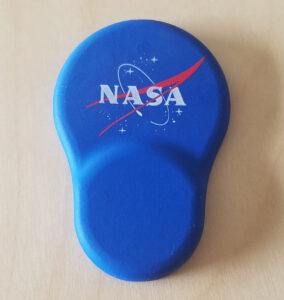Success Story: NASA Astrosense (In-space manufacturing, multi material fabrication with printed electronics)
Overview

NASA developed a next-generation wearable flexible sensor array for astronaut crew health monitoring, also known as “AstroSense”. Multi-disciplinary teams from Marshall Space Flight Center, Ames Research Center, and Flight Surgeons at Johnson Space Center all collaborated with NextFlex to design a wearable sensor array aimed at monitoring astronaut’s health and vital levels in space.
NextFlex’s Role
In the span of four months, the NextFlex team contributed to the development efforts of the next generation sensor for astronaut crew health monitoring by building and delivering a specific piece of hardware called a potentiostat for performing electrochemical analysis and printed disposable electrodes for use with artificial sweat samples. The team also performed biocompatibility tests, designed an encapsulating enclosure for moisture and dust ingress protection, and delivered several mock-up prototypes for demonstration purposes.
Benefits
With the support of NextFlex, the AstroSense device consists of two main components: a reusable electronic reader and a disposable electrode sensor. The reusable reader contains an antenna for wireless communication, electronic circuitry for data collection, processing and transmission for astronaut crew health monitoring, a coin battery and silicone encapsulant. The disposable electrode sensor consists of a flexible substrate with conductive electrodes and a stack of adhesives. The disposable sensor is attached to a reusable reader on one side and to human skin on other side. This next-generation wearable health monitor will allow NASA’s flight surgeons and health professionals to gain valuable data on the effect of stress upon the astronaut’s performance. This will lead to long-term improvements in the astronaut’s performance and overall health.
For more information, please contact info@nextflex.us
